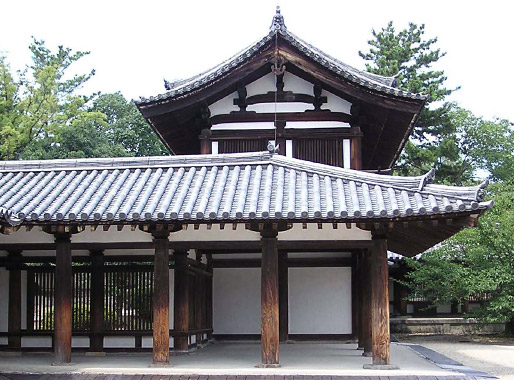|
||
 |
||

Houryuuji Kyouzou 法隆寺経蔵 (Nara)
(C)2001 Japanese Architecture and Art Net Users System. No reproduction or republication without written permission.
掲載のテキスト・写真・イラストなど、全てのコンテンツの無断複製・転載を禁じます。
|
||||||
| kyouzou 経蔵 | ||||||
| KEY WORD : architecture / buildings & structures | ||||||
| Also called kyouko 経庫, kyoudou 経堂, zouden 蔵殿. A repository and storehouse for sutras, or sacred books on Buddhism, or chronicles of temple history. In ancient times the kyouzou was placed opposite the belfry on an east-west axis. The earliest extant Kyouzou is at Houryuuji Sai-in 法隆寺西院, and is an example of the *rou-zukuri 楼造, or a double storied structure of 3×2 bays framed in plain timber. The pillars are stout and the bracket complexes *tokyou 斗きょう, are the right angle 3-on-1 type *demitsudo 出三斗, on the first story, and the 3-on-1 type *mitsudo tokykyou 三斗きょう, on the upper story. There are rainbow beams *kouryou 虹梁, with frog-leg struts *kaerumata 蟇股, in the gable pediments formed by the gable roof. The windows are filled with vertical lattice *renjimado 連子窓. See *garan 伽藍. An example of a kyouzou structured in log style *azekura-zukuri 校倉造, is found at Toushoudaiji 唐招提寺 (8c) in Nara. It is 3×3 bays,the usual size for sutra repositories, and has a tiled pyramidal roof *hougyou-zukuri 宝形造, with no bracket complexes, a single story high, on posts that support the floor well above the ground. All storage buildings are equipped with shelving to store the containers that hold the rolled sutras. The sutra repository at Daigoji 醍醐寺 (1198) in Kyoto, which burned down in 1939, was 3×2 bays. The aisle *hisashi 廂, was built primarily in the daibutsu style *daibutsuyou 大仏様, but has elements of the wayou style *wayou 和様, particularly the finely layered shingles *kokerabuki 柿葺, used instead of tiles and the use of eave supports *kayaoi 茅負, instead of fascia boards *hanakakushi-ita 鼻隠板. It had a revolving sutra storage case called *rinzou 輪蔵. It was circular with shelves for sutra storage. A central pillar revolved like a pivot. The eight sided cylindrical shelves were attached to it so that a priest could easily find the sutra he needed. Eventually ordinary people were permitted to push the rinzou around while praying, since it was believed that they could receive religious edification without actually reading the sutras. Example: Chion-in Kyouzou 知恩院経蔵 in Kyoto. | ||||||
 Houryuuji Kyouzou 法隆寺経蔵 (Nara)
|
||||||
| REFERENCES: | ||||||
| *houko 宝庫 | ||||||
| EXTERNAL LINKS: | ||||||
| NOTES: | ||||||
(C)2001 Japanese Architecture and Art Net Users System. No reproduction or republication without written permission. 掲載のテキスト・写真・イラストなど、全てのコンテンツの無断複製・転載を禁じます。 |
||||||